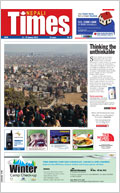| |
 Textual Tilaka, 2002: While some sadhus value a more energetic and impressionistic approach to tilaka, others value precision and complexity in their body art, such as this Vaisnavite ascetic, who has written sacred text across his face. |
In my adopted home of Kathmandu, some sadhus survive primarily off alms from tourists allowed to photograph them, considered a form of darshan. They are a spectacle and love to play their assigned role in the illusion or drama of society. Sadhus have formally abandoned conventional time; their world is dense with its own complex politics, social hierarchy, taboos and customs, often making access challenging.
Volatile and unpredictable as they are, spontaneous photography of sadhus can be dangerous. You can easily be trampled or attacked if you immerse yourself in a naga baba procession after a mass Kumbha Mela bathing. There's no such thing as achieving photographic acceptance within the Sadhu mandala. For me, photographing at ritual time is always the most dynamic and fluid. Once rapport has been established, a camera is tolerated, often with a sense of lila or maya, play and illusion.
 Aghori, 2000: The Aghori sub-sect of Shaivas most closely resembles one of the earliest organised groups of Hindu ascetics, the Kapalikas or 'bearers of skulls'. Like the modern-day Aghori, Kapalikas worshipped the terrifying manifestation of Shiva, Bhairab, and were known to perform human sacrifice. Though these extreme practices have evolved into symbolic acts today, the Aghori still use human skulls, as seen here. By drinking out of a skullcup (kapala) the sadhu partakes of the deceased's life-force. |
My initial inexplicable attraction to the Sadhu world was mostly visual. As a photographer, I loved how they allowed their bodies to become symbols of the sacred from walking around naked to remind us of our naked selves, to wearing ash to remind us what are bodies become, to dreadlocks to remind us of our natural wild natures devoid of social convention. Their bodies are texts that speak volumes. A sadhu's body is a map of the Hindu universe, for the body is a microcosm of the cosmos.
 Sadhvi, 2000: Though the vast majority of sadhus are men, women too renounce the worldly life for spiritual practice. Sadhvis, like the Vishnu devotee in this portrait, typically enter the ascetic life when they are older, usually widowed or still unmarried. Not all sects accept women, while a few are composed entirely of sadhvis. |
Thomas Kelly came to Nepal as Peace Corps Volunteer in 1978 and has lived here ever since. These photos are part of the exhibition 'Body Language: The Yogis of India and Nepal', currently showing at the Rubin Museum of Art, New York.


